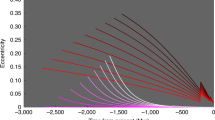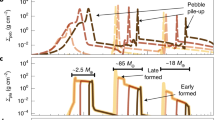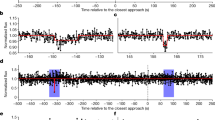Abstract
The origin and evolution of planetary rings is one of the prominent unsolved problems of planetary sciences, with direct implications for planet-forming processes in pre-planetary disks1. The recent detection of four propeller-shaped features in Saturn’s A ring2 proved the presence of large boulder-sized moonlets in the rings3,4,5. Their existence favours ring creation in a catastrophic disruption of an icy satellite rather than a co-genetic origin with Saturn, because bodies of this size are unlikely to have accreted inside the rings. Here we report the detection of eight new propeller features in an image sequence that covers the complete A ring, indicating embedded moonlets with radii between 30 m and 70 m. We show that the moonlets found are concentrated in a narrow 3,000-km-wide annulus 130,000 km from Saturn. Compared to the main population of ring particles6,7,8 (radius s < 10 m), such embedded moonlets have a short lifetime9 with respect to meteoroid impacts. Therefore, they are probably the remnants of a shattered ring-moon of Pan size or larger2, locally contributing new material to the older ring. This supports the theory of catastrophic ring creation in a collisional cascade9,10,11,12.
This is a preview of subscription content, access via your institution
Access options
Subscribe to this journal
Receive 51 print issues and online access
$199.00 per year
only $3.90 per issue
Buy this article
- Purchase on Springer Link
- Instant access to full article PDF
Prices may be subject to local taxes which are calculated during checkout




Similar content being viewed by others
References
Burns, J. A. & Cuzzi, J. N. Our local astrophysical laboratory. Science 312, 1753–1755 (2006)
Tiscareno, M. S. et al. 100-metre-diameter moonlets in Saturn’s A ring from observations of propeller structures. Nature 440, 648–650 (2006)
Julian, W. H. & Toomre, A. Non-axisymmetric responses of differentially rotating disks of stars. Astrophys. J. 146, 810–830 (1966)
Spahn, F. & Sremčević, M. Density patterns induced by small moonlets in Saturn’s rings? Astron. Astrophys. 358, 368–372 (2000)
Sremčević, M., Spahn, F. & Duschl, W. J. Density structures in perturbed thin cold discs. Mon. Not. R. Astron. Soc. 337, 1139–1152 (2002)
Marouf, E. A., Tyler, G. L., Zebker, H. A., Simpson, R. A. & Eshleman, V. R. Particle size distributions in Saturn’s rings from Voyager 1 radio occultation. Icarus 54, 189–211 (1983)
Zebker, H. A., Marouf, E. A. & Tyler, G. L. Saturn’s rings — particle size distributions for thin layer model. Icarus 64, 531–548 (1985)
Nicholson, P. et al. Saturns rings I: optical depth profiles from the 28 sgr occultation. Icarus 145, 474–501 (2000)
Colwell, J. E., Esposito, L. W. & Bundy, D. Fragmentation rates of small satellites in the outer solar system. J. Geophys. Res. 105, 17589–17600 (2000)
Esposito, L. W. & Colwell, J. E. Creation of the Uranus rings and dust bands. Nature 339, 605–607 (1989)
Colwell, J. E. & Esposito, L. W. Origins of the rings of Uranus and Neptune. I. Statistics of satellite disruptions. J. Geophys. Res. 97, 10227–10241 (1992)
Esposito, L. W. et al. Ultraviolet imaging spectroscopy shows an active saturnian system. Science 307, 1251–1255 (2005)
Porco, C. C. et al. Cassini imaging science: initial results on Saturn’s rings and small satellites. Science 307, 1226–1236 (2005)
Dones, L., Cuzzi, J. N. & Showalter, M. R. Voyager photometry of Saturn’s A ring. Icarus 105, 184–215 (1993)
Colwell, J. E., Esposito, L. W. & Sremčević, M. Self-gravity wakes in Saturn’s A ring measured by stellar occultations from Cassini. Geophys. Res. Lett. 33, 7201–7204 (2006)
Hedman, M. M. et al. Self-gravity wake structures in Saturn’s A ring revealed by Cassini VIMS. Astron. J. 133, 2624–2629 (2007)
Salo, H., Karjalainen, R. & French, R. G. Photometric modeling of Saturn’s rings. II. Azimuthal asymmetry in reflected and transmitted light. Icarus 170, 70–90 (2004)
Weidenschilling, S. J., Chapman, C. R., Davis, D. R. & Greenberg, R. in Planetary Rings (eds Greenberg, R. & Brahic, A.) 367–415 (Univ. Arizona Press, Tucson, 1984)
Albers, N. & Spahn, F. The influence of particle adhesion on the stability of agglomerates in Saturn’s rings. Icarus 181, 292–301 (2006)
Showalter, M. R., Cuzzi, J. N., Marouf, E. A. & Esposito, L. W. Satellite ‘wakes’ and the orbit of the Encke Gap moonlet. Icarus 66, 297–323 (1986)
Showalter, M. R. Visual detection of 1981S13, Saturn’s eighteenth satellite, and its role in the Encke gap. Nature 351, 709–713 (1991)
Seiß, M., Spahn, F., Sremčević, M. & Salo, H. Structures induced by small moonlets in Saturn’s rings: implications for the Cassini Mission. Geophys. Res. Lett. 32, 11205–11208 (2005)
Lewis, M. C. & Stewart, G. R. Features around embedded moonlets in Saturn’s rings: the role of self-gravity and particle size distributions. Icarus (submitted)
Durda, D. D. et al. Size frequency distributions of fragments from SPH/N-body simulations of asteroid impacts: comparison with observed asteroid families. Icarus 186, 498–516 (2007)
Karjalainen, R. & Salo, H. Gravitational accretion of particles in Saturn’s rings. Icarus 172, 328–348 (2004)
Hedman, M. M. et al. Saturn’s dynamic D ring. Icarus 188, 89–107 (2007)
Michel, P., Benz, W. & Richardson, D. C. Disruption of fragmented parent bodies as the origin of asteroid families. Nature 421, 608–611 (2003)
Daisaka, H., Tanaka, H. & Ida, S. Viscosity in a dense planetary ring with self-gravitating particles. Icarus 154, 296–312 (2001)
Cuzzi, J. N. & Estrada, P. R. Compositional evolution of Saturn’s rings due to meteoroid bombardment. Icarus 132, 1–35 (1998)
Spahn, F. & Sponholz, H. Existence of moonlets in Saturn’s rings inferred from the optical depth profile. Nature 339, 607–608 (1989)
Tiscareno, M. S., Burns, J. A., Hedman, M. M. & Porco, C. C. The population of propellers in Saturn's A ring. Astron. J. (submitted)
Acknowledgements
We acknowledge the efforts of the Cassini ISS team in the design and operation of the ISS instrument. This work was supported by the Cassini project, Deutsches Zentrum für Luft und Raumfahrt, Deutsche Forschungsgemeinschaft and the Academy of Finland.
Author information
Authors and Affiliations
Corresponding author
Ethics declarations
Competing interests
The authors declare no competing financial interests.
Supplementary information
Supplementary Information
The file contains Supplementary Methods with additional references, Supplementary Tables S1-S3 and Supplementary Figures S1-S16 with Legends. (PDF 4445 kb)
Rights and permissions
About this article
Cite this article
Sremčević, M., Schmidt, J., Salo, H. et al. A belt of moonlets in Saturn’s A ring. Nature 449, 1019–1021 (2007). https://doi.org/10.1038/nature06224
Received:
Accepted:
Issue Date:
DOI: https://doi.org/10.1038/nature06224
This article is cited by
-
Magnetic separation of general solid particles realised by a permanent magnet
Scientific Reports (2016)
-
The role of adhesion for ensembles of mesoscopic particles
Granular Matter (2012)
Comments
By submitting a comment you agree to abide by our Terms and Community Guidelines. If you find something abusive or that does not comply with our terms or guidelines please flag it as inappropriate.



